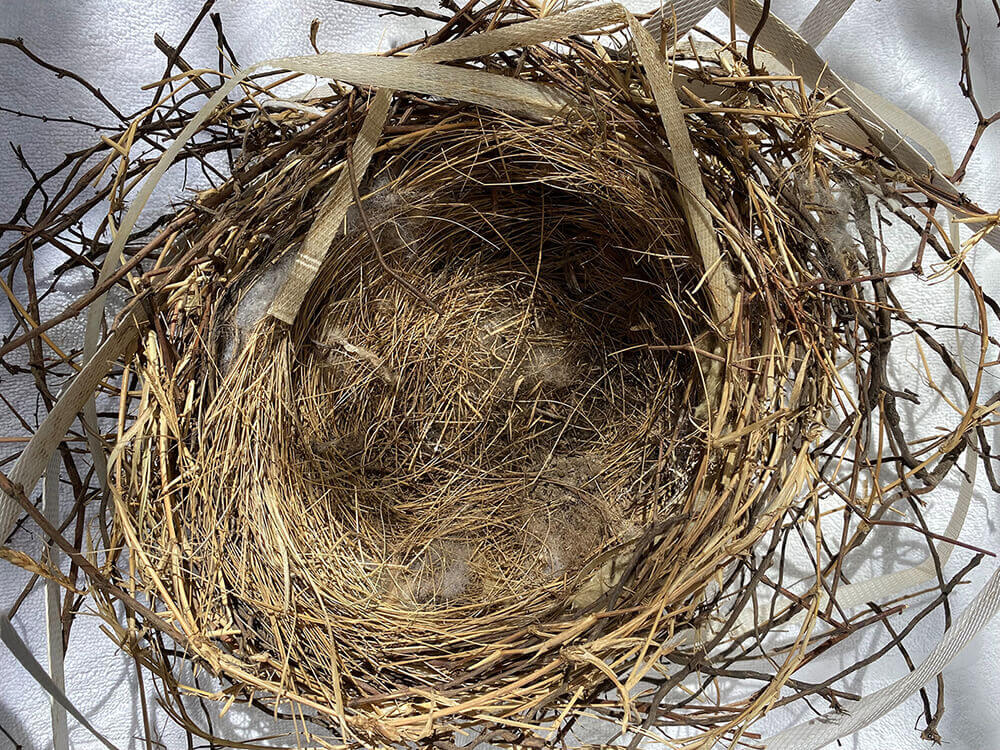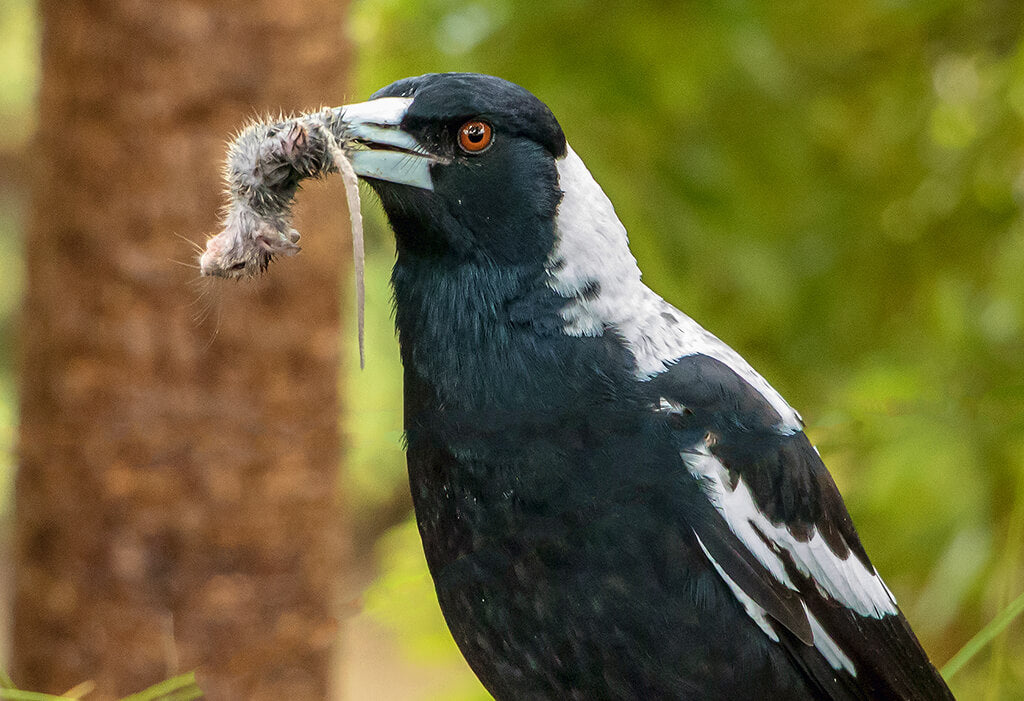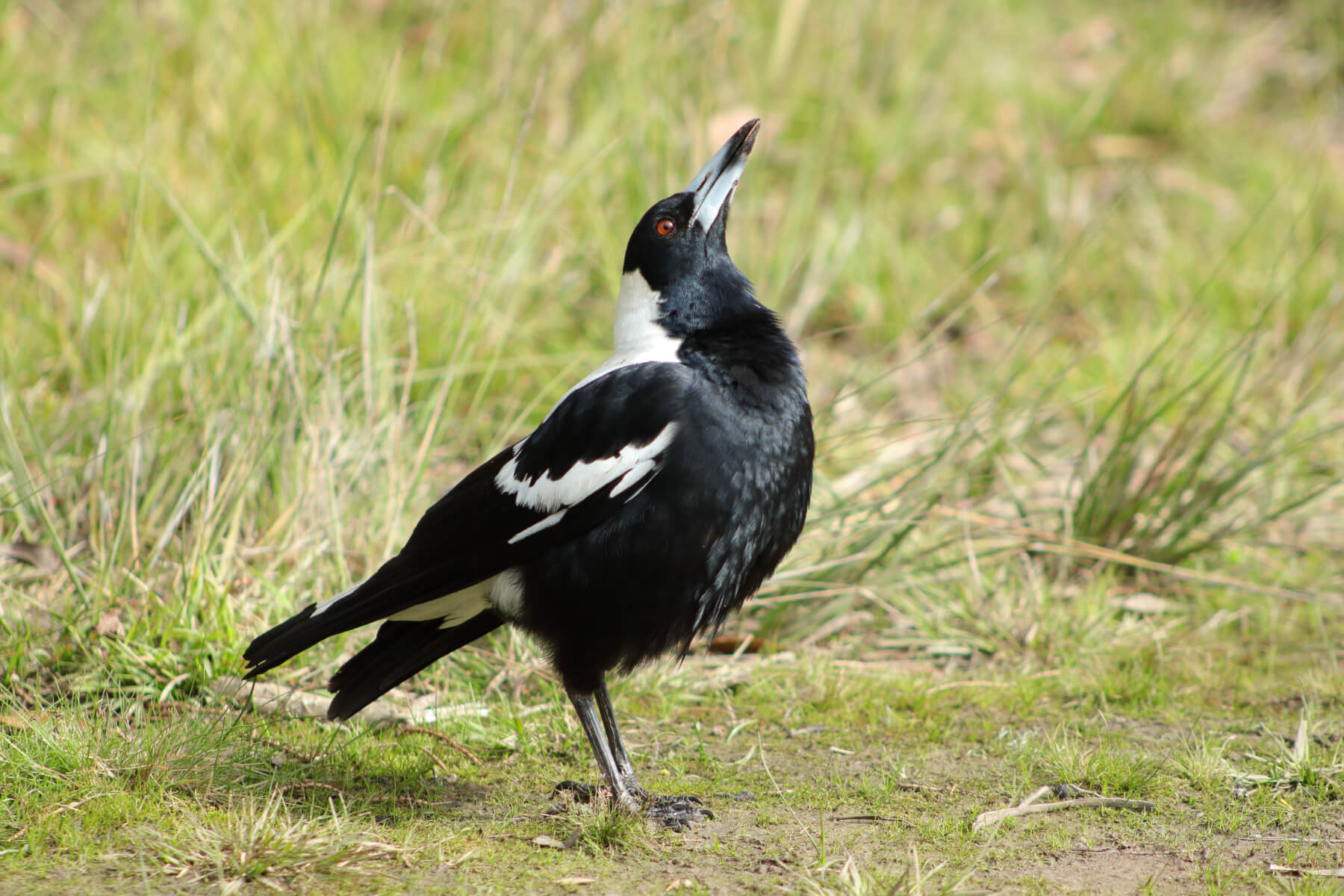The Remarkable Nesting Process of Australian Magpies: Location, Incubation, Hatching, and More
Posted by The Magpie Whisperer on

Male Magpie guarding the nest
Australian Magpies are known for their remarkable intelligence and adaptability, as well as their impressive nesting abilities. Their nesting process is a carefully planned and executed procedure, which involves selecting the ideal location for their nests and attentively caring for their young. From incubating their eggs to providing food and protection, Australian Magpies display a unique set of behaviours and practices that is both fascinating and commendable. In this article, we will delve deeper into the nesting process of Australian Magpies and explore the various stages involved in this remarkable process.
Magpie Breeding Season
The breeding patterns of magpies are influenced by their geographical location. While some magpies breed between the months of June and December, those in the Victorian and New South Wales Alps continue to breed until the end of January. However, the breeding season may vary in certain regions due to factors such as climate and weather conditions. For instance, a shortage of rainfall or extreme temperatures may impact the timing of the breeding season. Therefore, it is important to consider the specific environmental factors that may affect magpie breeding when studying these fascinating birds.
What Affects Where Magpies Build Their Nests?
Food Availability - Food availability is a crucial factor that determines where magpies build their nests. These birds require a variety of foods to sustain themselves and their young. As opportunistic feeders, they tend to build their nests in areas where they can find an abundant food supply.
Open fields, parks, and gardens are some of the preferred nesting sites for magpies due to the availability of food resources in these areas. They can easily find insects and other small animals in open fields and gardens. Moreover, these areas are often situated away from densely populated areas, providing a quiet and peaceful environment for the birds to raise their young.
Interestingly, magpies have also adapted to urban environments and can be seen nesting near people's homes or in trees lining city streets. These birds have learned to take advantage of human activities, such as gardening and waste disposal, to find food for themselves and their young. They have even been known to scavenge food from outdoor dining areas or open garbage cans, and people also feed them.
Safety - The safety of their eggs and young ones is a crucial factor that affects the location of magpie nests. Being aware of potential threats from predators such as snakes, cats, and birds, magpies choose to build their nests in tall trees that are hard for predators to reach. By building their nests up high, magpies can effectively monitor their surroundings and safeguard their offspring.
Temperature Regulation - Australian Magpies are also careful about the location of their nests to ensure the right temperature for their eggs and hatchlings. Magpies are known for selecting sites that offer protection from harsh weather conditions, such as direct sunlight, strong winds, and heavy rainfall. They prefer sheltered locations, such as under the canopy of trees or in dense shrubbery, that offer natural insulation against extreme temperatures.
Familiarity - Magpies are known for their strong homing instincts, which means that they often return to the same area where they have previously nested. They have an excellent memory and can recall details about a specific location, such as the presence of food, water, and nesting sites. Once they find a spot that meets their criteria for a suitable nesting location, they tend to stick with it and may return to the same location for several years in a row. This behavior is not only due to familiarity but also because returning to a successful nesting location increases their chances of successfully raising their young. By building their nests in the same spot each year, magpies can create a sense of familiarity which can contribute to their overall success in raising healthy offspring
In areas where there is a lack of tree coverage, magpies may sometimes resort to nesting in man-made structures such as buildings or even utility poles. This can be a risky move as these structures may not provide the same level of protection from predators or inclement weather as natural trees do. However, magpies are known to be adaptable birds and can make the best of the available nesting options.
Nest Building

Australian Magpie Nest
The nesting period is a crucial time for Australian Magpies. During this time, the female magpie takes on the critical responsibility of constructing the nest. It's essential to note that although the female Australian Magpie is primarily responsible for building the nest, the male may still help with gathering nesting materials. To begin the process, she collects materials, such as twigs, vines, and larger sticks, which she weaves together to create the structure of the nest. In cases where magpies are nesting near humans, they have been observed using coat hangers, twine, plastic strips and rope to construct their nests.
The construction stage requires significant effort from the female magpie, who can take several weeks to complete the task. She often returns repeatedly to the same site to gather more materials, ensuring that the nest is sturdy and secure enough to protect her eggs and eventual hatchlings.

A female collecting a cable tie to use in her nest
Once the frame of the nest is in place, the female magpie then lines the inside with softer materials like feathers, grass, bark, and animal fur. The nesting material serves to provide insulation for the eggs and chicks and creates a warm, cozy environment for the young ones to grow and develop. The female magpie is meticulous in arranging these materials in a manner that ensures maximum protection against external elements.
Egg Laying and Incubation

Australian Magpie Egg
After mating, the female Australian Magpie may take several days to lay her first egg, and it is not uncommon for 1 or 2 of the eggs to be infertile. Typically, a clutch of 2-5 eggs is laid, each having a light blue or greenish-blue color and spotted with brown or purplish hues.
The number of eggs in a clutch can vary depending on different factors. If food is scarce, the female may lay fewer eggs to conserve her energy for incubation and caring for the chicks. Conversely, if food is abundant, the female may lay more eggs. Environmental factors, such as weather and temperature, can also influence the number of eggs laid in a clutch.
Incubation - During the incubation period, the female Australian Magpie diligently tends to the eggs for approximately 20-23 days until they hatch, while the male provides her with food. The female's role is critical in ensuring the successful development of the eggs. She is responsible for maintaining the correct temperature (37-38°C) and humidity levels (50-60%) and adjusts her position on the eggs as necessary to provide the right amount of heat and humidity. Additionally, she regularly turns the eggs to ensure the embryos inside develop properly and evenly. This process is essential for the healthy growth of the embryos and increases the chances of successful hatching.
Post-Hatching Development of Magpies
The Australian Magpie chicks typically spend around 4 to 5 weeks in the nest before taking flight. They go through various stages of growth and development, with their rate of maturation influenced by a range of factors such as environmental conditions, food availability, genetic makeup, and overall health status.
The overall health status of the chicks is also critical to their growth and development. Diseases, injuries, or stress can impede their growth and development or even cause death. In contrast, good health can aid normal growth and development, preparing the magpie chicks for their first flight.
Please note that the stages below are based on my personal observations and may vary.
-
Week 1 - Hatchlings: Australian magpie hatchlings are born pink-skinned, bald, and with their eyes firmly shut. They spend much of their time sleeping and growing at a remarkable pace, only waking up when it's time to be fed. When an adult lands on the nest, the vibrations it creates alert the hatchlings to the presence of their parents and signal that it's time to eat.
-
Week 2 - Nestlings: During the second week of their life, Australian magpie nestlings start to open their eyes and develop pinfeathers on their wings and tail. This creates a noticeable contrast against their soft downy feathers on their rump, and their distinct black and white plumage begins to emerge, even in the early stages of their growth.
-
Week 3 - Branchlings: In Week 3, the Australian magpie chicks go through a significant developmental shift from being nestlings to branchlings. They become more mobile and start exploring their surroundings by standing up, despite being unsteady on their legs, and moving around the nest. As their wings begin to develop, their feathers become more prominent, giving them a more mature appearance. In preparation for their first flight, the chicks start to flap their wings and build muscle strength, preparing them to fledge.
- Week 4 - Fledglings: Week 4 marks an exciting milestone for Australian magpie chicks as they officially become fledglings. At this stage, they are fully feathered and ready to leave the nest to explore the surrounding area. They start by doing short flutters from branch to branch, building up their strength and coordination in preparation for longer flights.
Post-fledging
After fledging, juvenile Australian Magpies receive food from their parents for two to three months. The parents impart important skills such as foraging, vocalisations, and territorial defense. Generally, the juveniles remain with their parents for about 6-8 months before becoming fully independent.
In conclusion, the nesting procedure of Australian magpies is a fascinating process that highlights the intelligence and resourcefulness of these birds. From the selection of a suitable nesting site to the construction of the nest itself, magpies show remarkable adaptability and creativity in their approach. Their cooperative behavior during the nesting season, with both parents playing a crucial role in raising the young, is a testament to their strong family bonds and social structure.
Did You know?
Magpies feed their nestlings every 20 minutes.
Magpies do not start drinking water until several weeks after fledging




